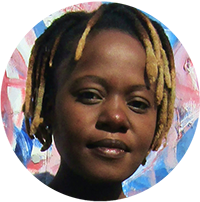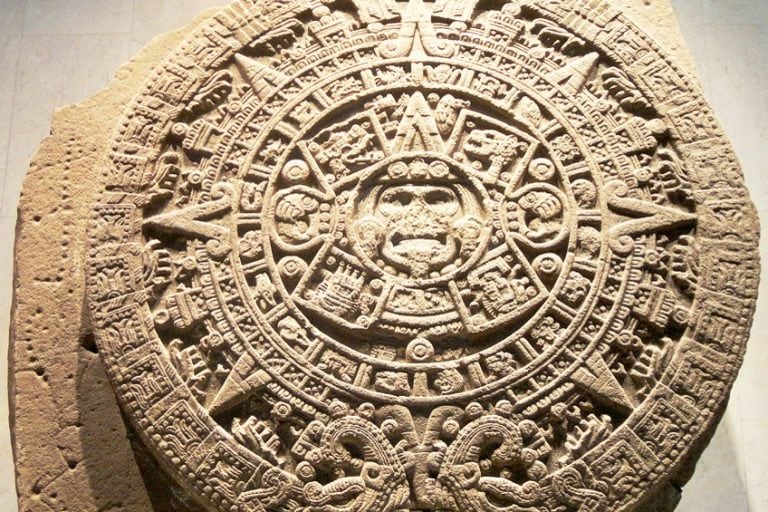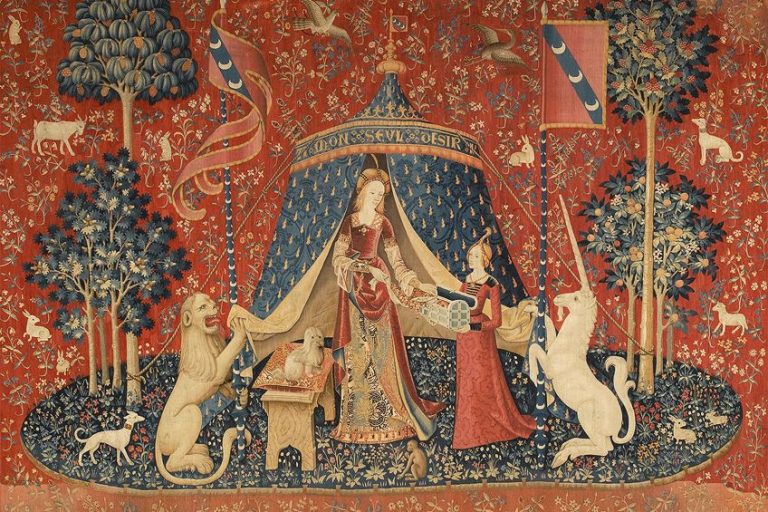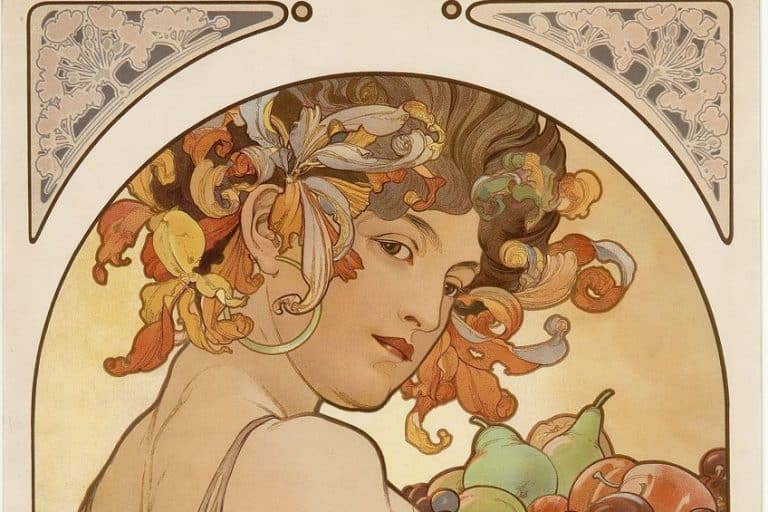Hyperrealism Art – The Best Hyper-Realistic Paintings and Artists
We are sure that you have seen artwork that looks incredibly realistic, artwork that leaves you thinking how the artist managed to pull it off. This is known as hyperrealism art, and it comes in a variety of forms that will leave you speechless. Most artists use art as an escape from reality, but the same cannot be said for hyperrealism artists, as they aim to erase the boundary that lies between art and reality.
What is Hyperrealism?
Hyperrealism is a relatively new art form that evolved from older movements; however, the traditional tools that are used to create art apply to this art genre as well. This includes paint, clay, graphite, ink, charcoal, and so on. Like all art forms, hyperrealism has some history behind it with a few pioneers that promoted and mastered the genre.
Hyperrealism is based on the aesthetic ideologies of photorealism and was promoted by a handful of artists out of the USA and Europe. Super-realistic or hyper-realistic art gained traction in the late ‘60s and early ‘70s. This is due to painters such as Chuck Close, Audrey Flack, Richard Estes, and Denis Peterson that created a painting based on photographs to achieve a hyper-realistic look that could easily be mistaken for a photograph.
Hyper-realistic sculptors and painters always used photographs as a reference to achieve a lifelike recreation of the image. This is where the difference between photorealism and hyperrealism art became evident, as photorealistic artists tried to recreate an image that had plenty of detail, whereas hyper-realistic art requires the artist to present the image as lifelike. This requires an immense focus on the subject, as every detail needs to be presented. Hyper-realistic art is essentially a depiction of reality, and there are often cases where the artwork cannot be differentiated from the reference.
Hyper-realistic sculptors and painters share a common goal, and that is to create a false reality. These artworks can be viewed as an extension of photographs that have been taken in an extremely high resolution. These artworks are constructed by using a variety of advanced techniques such as shading and subtle lighting effects. In hyper-realistic paintings, the frontal plane of the canvas generally depicts the forms, areas, and shapes that are at the front of the image. Sculptures are known for having more details than what would actually be found in nature – which is incredible.
Technology has now advanced to a point where art is advancing with it, and this includes hyperrealism. Digital art is a popular medium for creating hyperrealist sketches and paintings, and it can include a variety of elements that are unlikely to be found in nature.
The Hyperrealism Movement
Photorealism was borne from both Pop Art and as an answer to the Minimalist art and Abstract Expressionism Movement in the USA. It was argued that the use of a camera to help create their art was seen as an acceptance of Modernism. The acceptance of cameras and photographs was met with intense criticism when the Hyperrealism Movement gained traction as it approached the ‘70s. This was despite the fact that visual aids have been used in art since the 15th century.
After the invention of the camera, scenic and portrait artists were almost rendered obsolete, which caused many to adopt photography as a career. Those that chose to continue to create hyper-realistic paintings and sculptures went to great lengths to deny that they had used photographs as references. This is because they feared that their work would be misunderstood, and viewed as an imitation. However, the camera provided artists with references that opened a new world of experimentation.
The photograph had gained a lot of support and was seen as the best way to get realistic art. Whereas the art world was meant to focus on abstract pieces that could not be found naturally in the real world. As a result, hyperrealism was born and became incredibly popular, especially in the early 2000s. The first difference between photorealism and hyperrealism is that hyper-realism was borne from photorealism. Hyperrealism also focuses on creating a powerful image that can be used to narrate a political scene, whereas photorealism focuses on technique and the approach of the artist.
Themes
Hyper-realistic artwork can have a variety of subject matters that range from landscapes, narrative scenes, portraits, still life, figurative art, cityscapes, and more. However, some hyperrealists have gone as far as to expose dictatorial regimes by depicting their legacies of intolerance and hatred. This was mainly done by the likes of Latif Maulan, Gottfried Helnwein, and Denis Peterson. Each artist usually focused on something different and this is what made the style so popular, as it not only mimicked photography in a sense, but people were drawn to it due to the high-level techniques that were used.
Hyperrealism has proven to be a powerful art genre as it captures reality, and this can be done to recreate stories that play on a variety of human emotions. This is what makes it an art form that should be appreciated, especially if you are looking for art that has a deeper and more subliminal meaning.
Notable Artists
All art genres have artists that have paved the way for the next generation, having contributed greatly to the genre. Some of them are simply known for their talent. The list of both modern- and past-era artists below is displayed in no particular order.
Modern Era
Starting with the modern era, these are artists that stand out from the rest as their talents are known for being the best in the industry.
WForrest
Imagine being forced to record yourself creating digital art because people often mistake your work for photography. This is the case with WForrest, whose hyperrealistic paintings have earned him a mass following. He is known for creating more “natural” artwork.
Juan Francisco Casas
Some artists can create magical works of art with paint, silicone, and resin, but the amount of skill that you need to have to recreate a photographic image with a ballpoint pen is amazing. Juan Francisco Casas is well-known for his hyper-realistic drawings, and they look like someone has taken a photo and applied an ink filter on it via photoshop.
Jason de Graaf
Jason de Graaf is known for making life very difficult for himself as he enjoys adding a lot of challenging elements to his artwork. This includes a variety of reflections, complex shadows of translucent objects, liquid in motion, and so on. He is one of the best hyperrealism artists, and his work easily displays how talented he is.
Carole Feuerman
Being a sculptor is hard enough as it is, but opting to use resin – a significantly harder material than silicone – and creating hyper-realistic sculptures is a whole new level of talent. Carole Feuerman is known for having a great understanding of human anatomy, and she specializes in creating sculptures that appear to be wet. This is an incredibly challenging level of hyperrealism and it is a great way for her to showcase her skills.
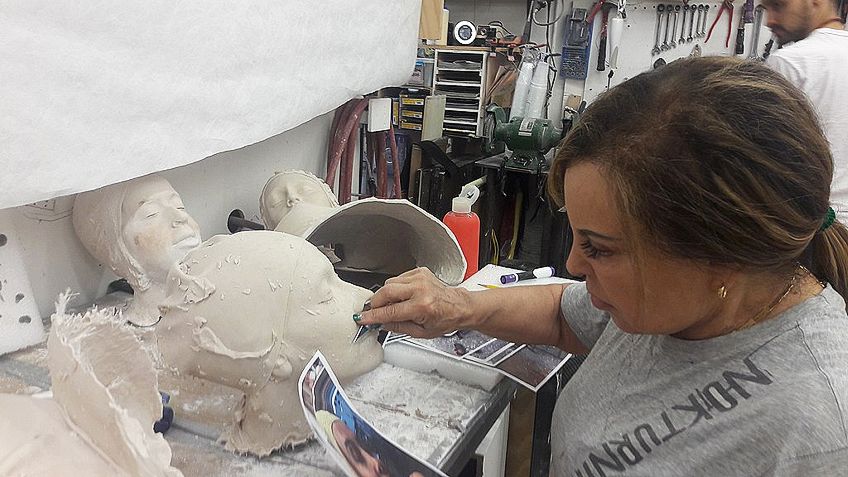
Evan Penny
Evan Penny is regarded as one of the best hyper-realistic silicone sculptors, as his creations appear to look like the models that they were based on. You will need to find the correct point of view to admire these models from, however, as any other angle would seem to be flat or odd.
Ron Mueck
It must be infuriating to live or work near Ron Mueck’s artwork as they look exactly like real people. Not only do his sculptures look the part, but they are made to scale. This is evident in one of his sculptures called “A Girl”, which is 16 feet long.
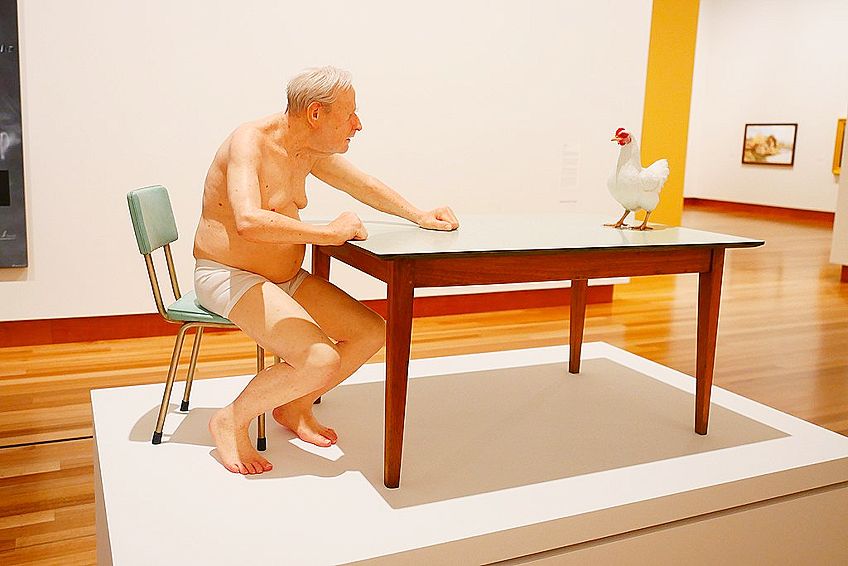
Sam Jinks
Sam Jinks is a silicone sculptor that specializes in recreating beautiful and unsettling artwork. And unlike hyper-realistic paintings, his sculptures are so realistic that people are advised not to try to help them during an exhibition.
Leng Jun
Leng Jun is known for creating the most realistic oil paintings, most of which are portraying women in natural positions. All of his paintings are depicted with incredible accuracy and attention-to-detail, and this is what makes him one of the best.
Jamie Salmon
When it comes to attention-to-detail, Jamie Salmon does not miss a pore, follicle, hair, freckle, or wrinkle when it comes to his silicone sculptures. His artwork is known to evoke vivid emotions within audiences, and this is why we believe that he could be one of the greatest modern sculptors.
Past Era
We cannot promote the present without acknowledging the past, and this is why we have included a few of the greatest artists that have contributed to hyperrealism.
Roberto Bernardi
Roberto Bernardi has the amazing ability to make you feel as if you are looking at a scene through your own eyes. And unlike most artists that are inspired by ordinary objects or scenes to recreate something beautiful, Roberto will bring out the beauty in the most mundane scenes, such as dishes inside a dishwasher.
Ralph Goings
The late Ralph Goings was one of the first artists to promote the photorealism movement, and he was known for his incredibly detailed paintings of fast food and automotive vehicles. Ralph was inspired to create art that was the complete opposite of abstract images.
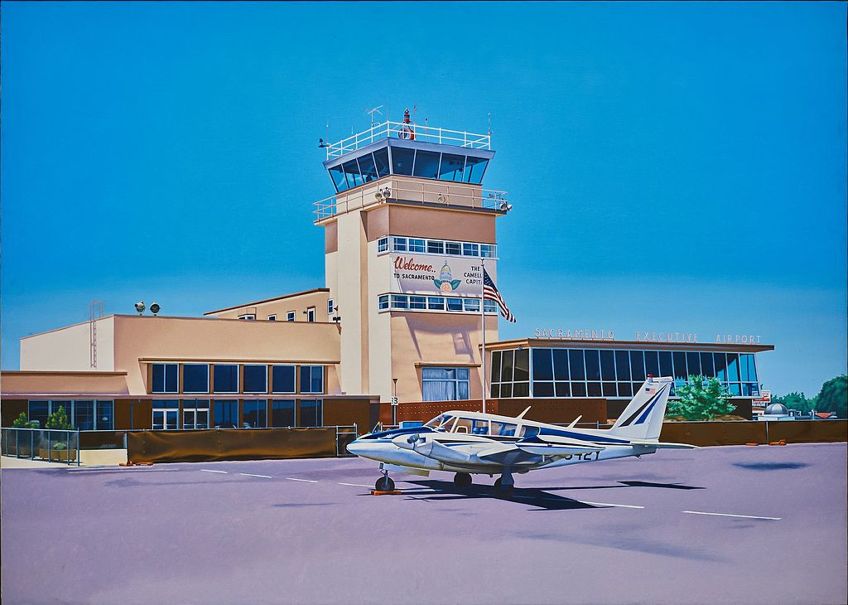
Thomas Eakins
Thomas Eakins is recognized as a major part of the history of American art and is one of the most noteworthy artists leading up to the hyperrealism movement. This is due to his contribution to the realism movement and bringing art to a commercial level, which is why you see this kind of art inside hospitals and offices. Eakins is known for creating the Portrait of Ashbury W. Lee and The Gross Clinic.
Audrey Flack
Audrey Flack is an artist that is known for her photography, painting, and sculpting, all of which contributed to the photorealism movement. Audrey Flack is best known for her paintings, and she is known to be one of the first artists to use a photograph as a reference.

What Makes Hyperrealism an Art Genre?
We live in an era where anything and everything can be classified as art just because an artist says so. This is why you would often see plenty of bad art being sold for thousands of dollars, including the Obvious collective’s Portrait of Edmond de Belamy, which is nothing more than a large smear with an expensive frame around it. Art is an emotional expression, and even if the artist is trying to be as emotionless as possible, it remains a form of expression. So, that leaves us with the question regarding hyperrealism: What exactly makes it an art genre?
Hyperrealism takes tremendous effort, incredible discipline, and skill – a lot of skill. There is no reason why these works of art should not be celebrated, as they accurately capture the essence of what is real; they evoke emotion and are a testament to the abilities of human beings. Some critics label hyperrealists as obsolete, but these are the individuals that miss the point. Art does not have to have a purpose. What you get with hyperrealism is what you are trying to escape when looking at art: reality. And here you are given an image that has been translated from something that already exists.
Hyperrealism thrives on the imperfections of an image, and as perfect as the image is “copied”, it retains all of the imperfections of the original. What we like about hyperrealism is that it can teach us to see the beauty in ordinary things. A pile of dishes as a photograph will raise eyebrows, but a hyperrealist sketch of that image will drop jaws.
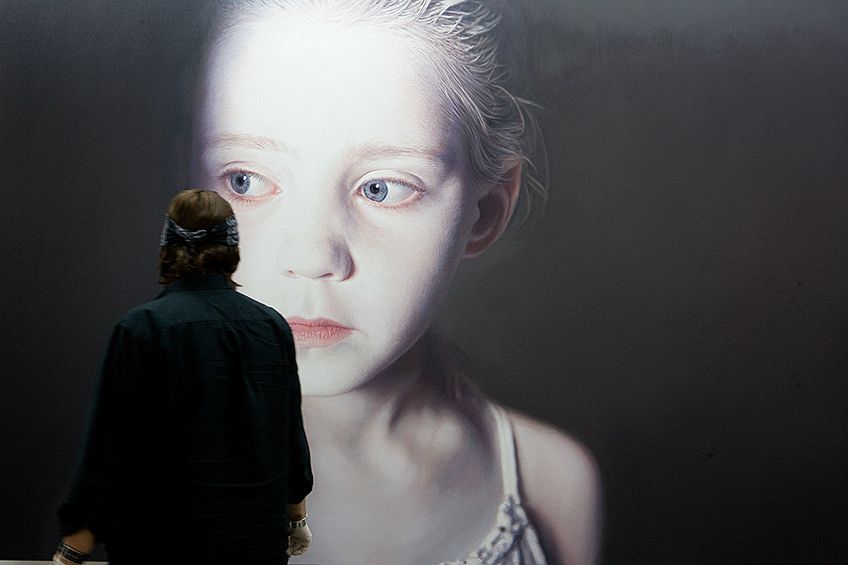
Understanding the Difference Between Hyperrealism and Photorealism
Isy Brachot was the first person to use the term ‘hyperrealism’ in 1973, as it was the name of an exhibition that took place at his art gallery. There were a variety of high-profile artists that had their work on display, including the likes of Ralph Goings, Don Eddy, Chuck Close, and Robert Bechtle. Since this particular event, the term hyperrealism has been used to refer to the artists that have been inspired by the photorealists.
Due to the roots of these artists being planted in photorealism, they then tried to depict their work as realistic as possible. This resulted in a contrast between photorealism and hyperrealism as the former took a literal approach, and this was clearly seen in traditional paintings. Photorealism tends to emulate the photo that is used as a reference, whereas hyperrealism attempts to create an altered overall design that introduces a component that may not be there in real life. This is where hyperrealism tends to go beyond what is seen and to enhance the reality that was initially portrayed.
There are a few ways to tell if an image is hyper-realistic, but it is not easy. These features are primarily the shadows, lighting effects, surfaces, and textures that appear to be more definite and vibrant. However, the sculptures and the paintings are just the surface of what needs to be found, as the image is a new take of an existing reality. This means that the emotions that you will experience will likely be different, which is ultimately the significance of this “false reality”.
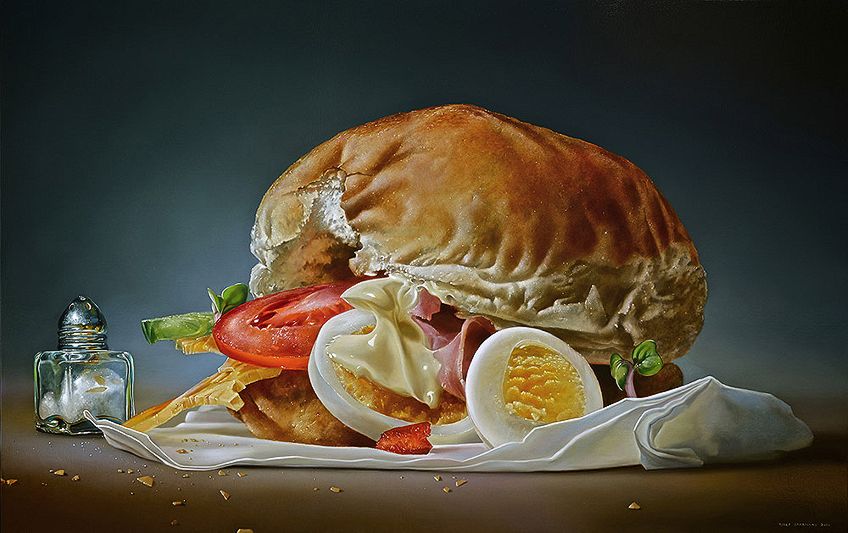
The Use of Color in Hyperrealism
As human beings, we are psychologically affected by color, and various shades will result in different emotions. Blue is usually capable of invoking feelings of tranquility, whereas black is associated with fear or unhappiness, and red could invoke feelings of passion or enthusiasm. The colors that are used in an art piece will affect you, and it will cause you to feel a particular way towards it. With hyperrealist artwork, this experience is enhanced to a new level, as we are perceiving it to be real. This is why particular pieces will invoke feelings of discomfort, sympathy, or anger.
Artists have learned to use accurate color palettes to achieve a result that cannot be separated from reality. Even though the proportions of the subject might be slightly incorrect, the colors that are used will play a significant role in making you feel as if you are looking at the real thing. Below you will find a table that explains the psychological effects of certain colors.
| Color | Emotion/Feeling |
| Black | Power Sophistication Death Evil Mystery |
| White | Purity Light Simplicity Hope Cleanliness |
| Red | Passion Danger Excitement Romance Urgency |
| Blue | Calmness Peace Integrity Confidence Sincerity |
| Yellow | Joy Energy Warmth Caution Intellect |
| Green | Growth Life Money Freshness Relaxation |
| Gray | Security Authority Maturity Strength of Character Stability |
| Purple | Luxury Royalty Magic Wisdom Vision |
| Pink | Love Beauty Sensitivity Sincerity Sophistication |
The Most Popular Pieces of Hyper-Realistic Art
Like every art genre, some pieces stand out from the rest. These are pieces that inspire us, invoke new feelings, or bring up old ones. Below are some of the most popular hyper-realistic art pieces that have ever been made.
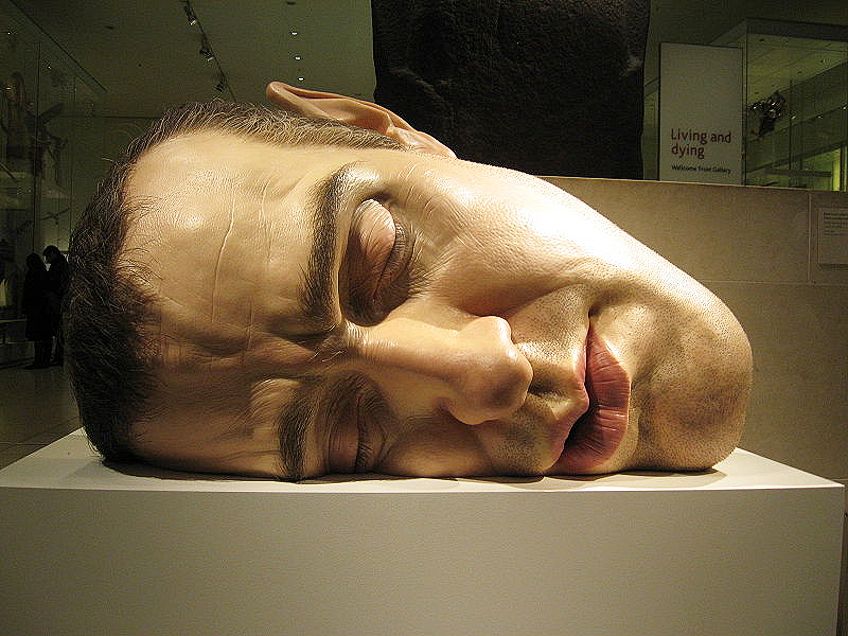
Spooning Couple by Ron Mueck
This is a hyper-realistic sculpture that was created by Ron Mueck in 2005. It depicts a man and a woman lying together in a spooning position. Both figures have been given a similarly light tone and are barely clothed. The only aspect of this sculpture that prevents it from being completely realistic is its scale, which is half the size of the average person. Mueck always starts the process with drawings before he creates small maquettes that are made from clay or plaster. From the previous step, he will then create some mold sections before casting the sculpture in fiberglass.
The fiberglass sculpture is then painted, and smaller details are added such as the hair and the eyes. This sculpture is one of the best examples of hyperrealism, and if it were life-sized, you would be forgiven for thinking that those were real people.
Wild Man by Ron Mueck
Another sculpture by Ron Mueck was also created in 2005. This portrays a large nude man sitting on a stool. He has a light skin tone and has been created with incredible realism. The man is in a strange position, with his arms elevated to his ears, while his heels are lifted and his toes are driven into the floor. His arms and back are straightened, with his hands grasping the edges of the seat. The Wild Man is a tense sculpture that has been made with fiberglass, aluminum, synthetic hair, polyester resin, silicone, and wood.
Girl by Lisa Milroy
This landscape-orientated painting was done in 1998 by Lisa Milroy and it portrays a young woman against a black background. This image captures her left-hand side, where the only part of her body that is illuminated in her face, with her neck reaching into the shadows. This image is captured in a realism format with a very smooth surface as the paint has been applied in thin layers.
Room by Lisa Milroy
In 1997, Lisa Milroy created Room, a 1750 x 1983 mm oil painting that portrays a traditional Japanese room. The room is decorated in subtle colors that complement the minimalist furnishings. The realistic open space is one of her finest paintings, and the only aspect of it that prevents it from being viewed as a photograph is the reflection of light on the center beam.
Tweety and Bunny by Roberto Bernardi
This delicious-looking oil painting was done by Roberto Bernardi in 2017, and it displays a variety of colorful lollipops. Roberto managed to capture the correct texture of the candy without compromising on the design, and the wrapping looks flawless.
Coke Trilogy by Pedro Campos
This is a series of oil paintings that portray three cans of soda inside a transparent plastic bag. This is a great demonstration of superior attention-to-detail and patience. Furthermore, Pedro is known for producing high-quality artwork on canvas, most of which portrays canisters, fruits, glass jars, and so on.
Girl with a Pearl Earring in Plastic by Tjalf Sparnaay
It is one thing to accurately recreate a classic portrait, but to do so and portray it as it is being sold as a cheap knock-off at a market is incredible. Tjalf Sparnaay is known for hitting extraordinary heights within the hyperrealism genre, and by adding a simple concept to a timeless piece of artwork, he created something truly extraordinary.
Mona Lisa by Leng Jun
Not the original Mona Lisa, but rather her high-resolution cousin. This painting was done in 2004 and it is scary how detailed it is. Every strand of the woman’s jumper can be seen, along with her hair, and the reflection of her eyes. This is an elite level of painting that few artists will ever reach unless they are willing to put in the work.
Light on my Shoulder by Sheryl Luxenburg
This an acrylic portrait that was done on paper and portrays a young woman with a faint smile and sunlight hitting the back of her head from the left. This is one of the most natural-looking paintings we have seen in a while and it is a testament to Sheryl’s ability as an artist.
Creating Hyper-Realistic Art
Now that you have a good idea of what hyperrealism artwork consists of, you would likely want to try it for yourself. However, this is not something that can be mastered in just a few months, as there are plenty of principles and techniques that will need to be applied.

Drawings
These tips are based on the assumption that you have the basic ability to work with materials such as charcoal, blending stumps, graphite, erasers, various pencils, and so on. The concept of hyperrealism is not as complex as it seems, but it is a highly mechanical endeavor. Start with procuring a detailed image that has no pixelation – a high-resolution photograph will work best. The next step is to lightly draw a grid onto the paper that you are using. This is to keep the proportions the same so as to prevent distortion.
Using a piece of tracing paper, trace the basic lines of the drawing, but do not try to add any details. Then transfer these lines onto the main piece of paper that contains the grid. The next step will require a lot of patience, as this is where you will need to zoom into the individual cells of the photograph and start to match the tones. This is why it is vital to use a high-quality photograph. It will be tempting to try and fill in individual shading and details before completing this part of the project, but do not do it.
Focus on matching the cells and take your time, ignoring the rest of the drawing. This is a mechanical way of completing the drawing and it can be quite satisfying, but you will need to stick to the aforementioned tips.
Sculptures
Unlike drawings, sculptures can be much more challenging and require more skill and knowledge of working with particular materials or with software. There is no step-by-step guide to creating hyper-realistic sculptures, but there are guidelines that will help.
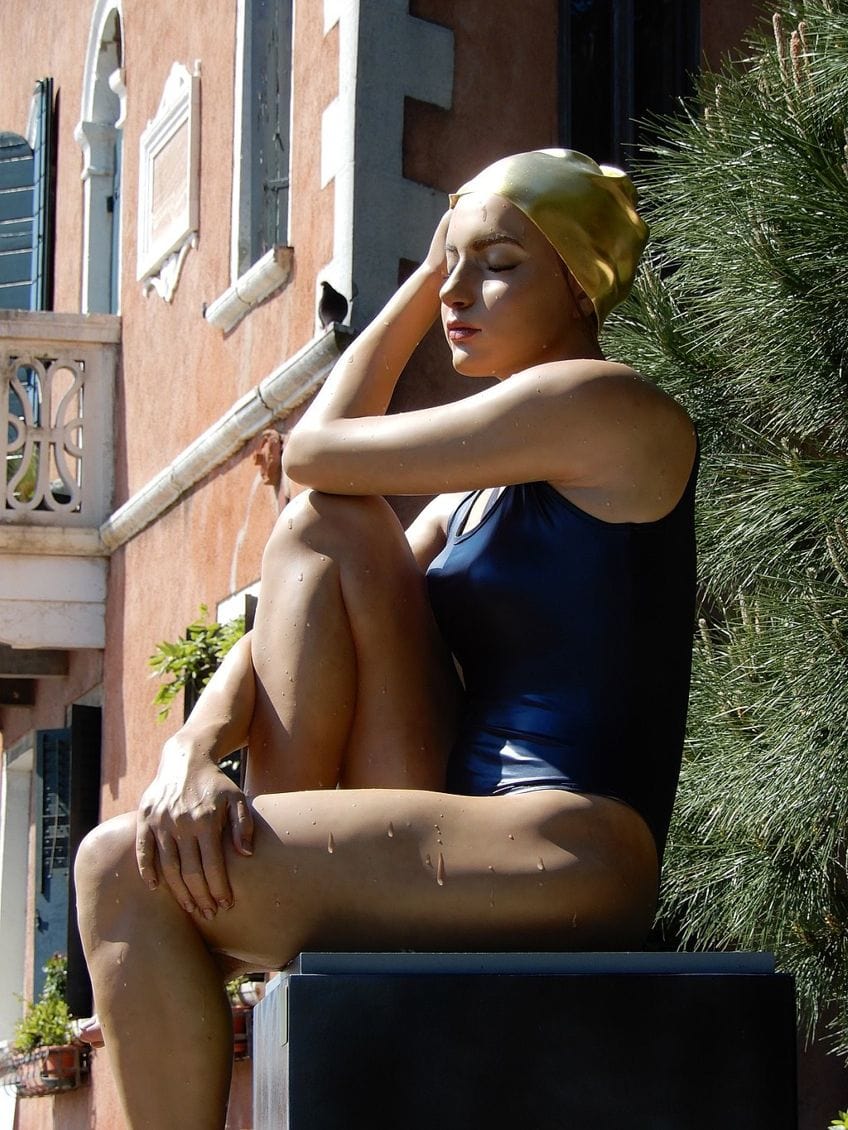
Use a Reference
Keeping a portfolio of references will help you to draw inspiration from them, and these should only be real-life references. 3D models of bodies and even keeping books that are based on the structures of particular animals or objects such as machines will prove to be helpful.
Understand the Anatomy of the Person or Animal
Each life form is built differently, and this will apply to your sculpture as well. The same rules need to be applied to your work, which is why you should know how the legs of a cat are structured or how muscles contract with each movement.
Vegetation and Plants
The same rules that apply to the anatomy of a person or animal will apply to a plant too. You will rarely find a tree or a flower that is perfectly symmetrical in real life, so by using ZBrush software, you will easily be able to create plant life effortlessly when using tools such as Radial Symmetry.
Apply Physics
To create a realistic structure, you will need to use real-world physics. ZBrush will allow you to add weight to the 3D model that you are working on to produce a sculpture that looks as if it is part of the real world.
Avoid Symmetry
As with most things in this world, nothing is perfect, and this applies to your sculpture as well. Breaking the symmetry will give your project a more natural look, and this can be done by turning the head of the character or twisting certain parts of the body.
These are a few basic tips that can prevent your sculpture from looking less realistic. To save money on expensive materials, the best thing to do is to try your hand with different types of software. Once you feel that you are confident enough to tackle a real sculpture, then you should try working with and understanding different materials such as various types of resin, fiberglass, silicone, and so on. Hyper-realistic sculptures will take years to master, so do not try to achieve perfection when doing it the first time.
You can also have a look at hyperrealism.net as an excellent source for this art form.
Frequently Asked Questions
How is Hyperrealism Achieved?
Hyperrealism is achieved by using a clear reference and replicating it. Then, particular features such as shadows and textures are enhanced to create a hyper-realistic effect.
Are There Distinct Differences Between Hyperrealism and Realism?
Realism is done by replicating an image, whereas hyperrealism is done with emotion and it is meant to evoke particular feelings within the viewer.
What Constitutes a Hyper-Realistic Sketch?
A hyper-realistic sketch is done by using a clear reference and a variety of different pencils to achieve a particular look that is somewhat beyond what the reference portrayed.
What is Believed to Be the Most Realistic Painting in the World?
A collection of art work done by hyperrealism master Leng Jun is considered to be the most realistic set of paintings of all time.
Heidi Sincuba was the Head of Painting at Rhodes University from 2017 to 2020 and part of the first Artist Run Practice and Theory course at Konstfack in Stockholm, 2021. They completed their BFA at Artez Arnhem in the Netherlands, MFA at Goldsmiths University of London, and are currently a Ph.D. candidate at the University of Cape Town.
Heidi Sincuba’s own practice explores fugitivity through painting, drawing, text, textiles, performance, and installation. This praxis is founded on a conceptual intersection of biomythographic experimentation, existential automatism, and African ancestral knowledge systems. These methodologies of multiplicity result in a fluid and speculative aesthetic, continually manifesting and metamorphosing its material conditions.
Learn more about the Art in Context Team.
Cite this Article
Thembeka Heidi, Sincuba, “Hyperrealism Art – The Best Hyper-Realistic Paintings and Artists.” Art in Context. January 22, 2021. URL: https://artincontext.org/hyperrealism-art/
Sincuba, T. (2021, 22 January). Hyperrealism Art – The Best Hyper-Realistic Paintings and Artists. Art in Context. https://artincontext.org/hyperrealism-art/
Sincuba, Thembeka Heidi. “Hyperrealism Art – The Best Hyper-Realistic Paintings and Artists.” Art in Context, January 22, 2021. https://artincontext.org/hyperrealism-art/.


